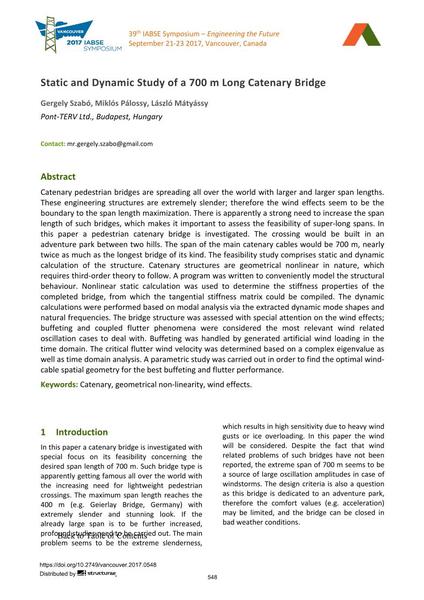Static and Dynamic Study of a 700 m Long Catenary Bridge

|
|
|||||||||||
Bibliografische Angaben
| Autor(en): |
Gergely Szabó
(Pont-TERV Ltd., Budapest, Hungary)
Miklós Pálossy (Pont-TERV Ltd., Budapest, Hungary) László Mátyássy (Pont-TERV Ltd., Budapest, Hungary) |
||||
|---|---|---|---|---|---|
| Medium: | Tagungsbeitrag | ||||
| Sprache(n): | Englisch | ||||
| Tagung: | IABSE Symposium: Engineering the Future, Vancouver, Canada, 21-23 September 2017 | ||||
| Veröffentlicht in: | IABSE Symposium Vancouver 2017 | ||||
|
|||||
| Seite(n): | 548-555 | ||||
| Anzahl der Seiten (im PDF): | 8 | ||||
| Jahr: | 2017 | ||||
| DOI: | 10.2749/vancouver.2017.0548 | ||||
| Abstrakt: |
Catenary pedestrian bridges are spreading all over the world with larger and larger span lengths. These engineering structures are extremely slender; therefore the wind effects seem to be the boundary to the span length maximization. There is apparently a strong need to increase the span length of such bridges, which makes it important to assess the feasibility of super-long spans. In this paper a pedestrian catenary bridge is investigated. The crossing would be built in an adventure park between two hills. The span of the main catenary cables would be 700 m, nearly twice as much as the longest bridge of its kind. The feasibility study comprises static and dynamic calculation of the structure. Catenary structures are geometrical nonlinear in nature, which requires third-order theory to follow. A program was written to conveniently model the structural behaviour. Nonlinear static calculation was used to determine the stiffness properties of the completed bridge, from which the tangential stiffness matrix could be compiled. The dynamic calculations were performed based on modal analysis via the extracted dynamic mode shapes and natural frequencies. The bridge structure was assessed with special attention on the wind effects; buffeting and coupled flutter phenomena were considered the most relevant wind related oscillation cases to deal with. Buffeting was handled by generated artificial wind loading in the time domain. The critical flutter wind velocity was determined based on a complex eigenvalue as well as time domain analysis. A parametric study was carried out in order to find the optimal wind- cable spatial geometry for the best buffeting and flutter performance. |
||||
